(via TheNewswire)
Data Compilation Reveals Significant Historical Gold Values with 3D Interpretation Now Underway
Vancouver, British Columbia – Nov 20, 2025 – TheNewswire - Cascade Copper Corp. (CSE: “CASC”) (“ Cascade ” or the “ Corporation ”) is pleased to announce that it has completed an initial compilation program of historical exploration and mining data on its Bendor Gold-Tungsten Project (the “ Project ”), located ~15 kilometres northeast of the prolific Bralorne Gold Mine near Gold Bridge, British Columbia, Canada.
Summary:
Project located proximal to Talisker Resources’ Bralorne Mine and Endurance Gold’s Reliance Project
Historical samples from underground workings at Bristol assayed up to 30.86 g/t Au and 6.5 % WO
A 23kg bulk sample taken from a winze reportedly assayed 48 g/t Au, 20.6 g/t Ag, and 0.16 % WO
Historical Chip sampling from the Bristol Level 2 Drift returned from 0.6 g/t Au up to 32.5 g/t Au
Exploration Drilling from the Bristol Level 3 Drift returned a highlight assay of 27.5 g/t Au over 5.3m including 70.0 g/t Au over 0.8m
Historical trench samples along the 225m long Benboe Vein assayed up to 16.4 g/t Au and 17.14 g/t Ag
Historical grab samples at the Silverside showing assayed up to 1.03 g/t Au, 72 g/t Ag, and 9.6 % Cu
Widespread untested gold-in-soil anomalies across the Project
Next Steps:
3D magnetic inversion of the recent airborne magnetic-radiometric survey data and integration into a cohesive geological model of the mineralizing environment to aid future exploration and drill targeting
Plans to submit a diamond drilling and geophysics permit application within the next month, following completion of the Project-wide 3D magnetic inversion and data modelling
These efforts will potentially lead to targeted diamond drilling in 2026
After initial compilation, the Corporation believes that the gold and tungsten mineralization reported from the historic Bristol Mine workings and adjacent mineralized vein systems could continue along strike and to depth. Historical samples from underground workings at Bristol are reported to have assayed up to 30.86 g/t gold and 6.5 % tungsten trioxide (WO 3 ) and a 23kg sample taken from a winze reportedly assayed 48 g/t Au, 20.6 g/t Ag, and 0.16 % WO 3 .
Shannon Baird, VP Exploration for Cascade Copper remarks “The previous exploration work at Bendor has shown some impressive values of gold, tungsten, and silver throughout the Bristol and Benboe workings and vein systems. We are extremely excited to complete the magnetic inversion modelling and 3D interpretation in preparation to get on the ground and follow up on these historic results. By all indications, there exists significant potential to expand on the mineralized gold system at Bendor.”
The Bendor Project has only had minimal surface exploration work in the past and has only been shallowly drilled within a narrow region surrounding the historic mine workings at Bristol. The recent depletion of year round snow cover has exposed additional large areas of copper mineralized veining, massive pyrrhotite lenses, and alteration on the north side of the Bendor Pluton now referred to as the “Oxide Ridge.” The Company has also completed an ultra high-resolution LiDAR and orthophoto survey and airborne magnetics-radiometrics survey that has revealed important structures and alteration patterns that will help prioritize future exploration programs.

Click Image To View Full Size
Figure 1: Bendor Project Locations in Relation to Bralorne Mine, Reliance Prospect and Major Centres
Previous Exploration Highlights*
Bristol Shear Zone and Mine Workings
From 1936 to 1946, three adits and a short winze, totaling ~333 metres were completed with reported grab sample assays up to 30.86 g/t Au and 6.5 % WO
Level 2 Drift sampling of 17 grabs returned assays ranging from 0.6 g/t Au to 32.5 g/t Au
A 23kg bulk sample taken from a winze assayed 48 g/t Au, 20.6 g/t Ag, and 0.16 % WO
In 1947, a 2,743 metre underground exploration diamond drill program was completed from surface and the Bristol Level 3 Drift to test down-dip extensions. Highlight assays include:
27.5 g/t Au over 5.3m including 70.0 g/t Au over 0.8m
1.09 g/t Au over 11.0m including 2.95 g/t Au over 2.0m
1.22 g/t Au over 8.65m
1.15 g/t Au over 4.0m
2.35 g/t Au over 2.15m
3.65 g/t Au over 1.8m
7.5 g/t Au over 1.0m
6.78 g/t Au over 0.9m
7.5 g/t Au over 0.6m, and
2.62 g/t Au over 0.7m
Gold mineralization occurring in the vicinity of the Bristol workings is hosted by five shear zones (East, Hangingwall, Main, Footwall, and Tommy Creek) in which the rocks are variably altered to an assemblage of quartz, carbonate, clay, pyrite, pyrrhotite, and limonite
The Main shear zone corridor is believed to contain fairly uniform anomalous gold content with lenses or pipes of high-grade gold and/or gold-tungsten and ~0.5 to 6.0 metres in width
Benboe Vein
In 1936, a 14.6m adit was completed and reported assays of 12.34 g/t Au and 17.1 g/t Ag
Historic trenching assayed up to 16.4 g/t Au and 17.14 g/t Ag over a ~1m wide quartz vein mapped along strike for at least 225m
Consists of vuggy quartz-carbonate and breccia along a sheared volcanic-sediment contact
Another area of quartz veining and rusty shearing hosting gold values was reported ~450m to the north along strike where a chip sample assayed 3.35 g/t Au over 1.0m
NE-trending veins at the Bralorne Mine and Bendor parallel the major north-trending, steeply southwest-dipping Cadwallader Break Fault system
Bristol 11
Historic chip sampling resulted in a sample assaying 1.69 g/t Au gold over 8.0m, including rock chip samples yielding up to 3.65 g/t Au and 0.296 % Zn over 1.0m
Another similarly mineralized shear zone located approximately 250m to the west returned two chip samples at 0.42 g/t Au and 1.33 g/t Au
Another rock sample from the area assayed 0.824 % Cu and 8.4 g/t Ag
Silverside Showing
The main quartz vein averages ~1m in width and is exposed for at least 250 metres containing white or glassy quartz with limonitic staining
The main vein has 3-4 % pyrite and arsenopyrite, 2-3 % galena, and possibly stibnite.
Historic grab samples assayed up to 1.03 g/t Au, 72 g/t Ag, and 0.23 % Pb
A 0.25m chip sample assayed 9.62 % Cu, 48 g/t Ag, and 1.77 % Zn
Silverside Extension
Oxide Ridge
New ~1km long oxidation zone discovered by Cascade with no previous work
Quartz-pyrite-chalcopyrite veining and massive pyrrhotite lenses containing elevated copper found throughout the ridgeline and scree slope ranging from 0.01 % Cu up to 0.20% Cu
Chalcopyrite-quartz veining encountered in the vicinity of the Bendor Pluton with four grab samples taken from the zone ranging from 0.06 % Cu up to 0.29% Cu
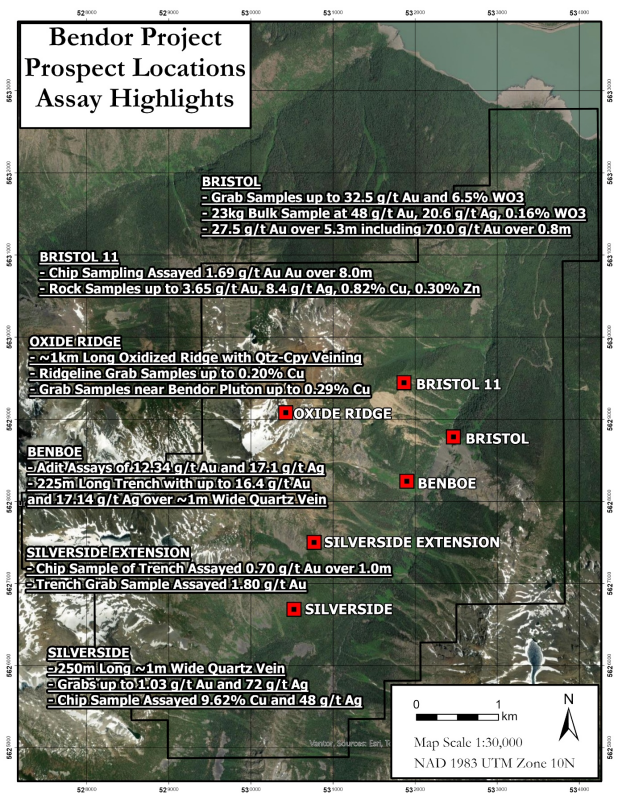
Click Image To View Full Size
Figure 2: Bendor Project Prospect Locations and Related Historic Assays Highlights
2025 Data Compilation and Areas of Interest
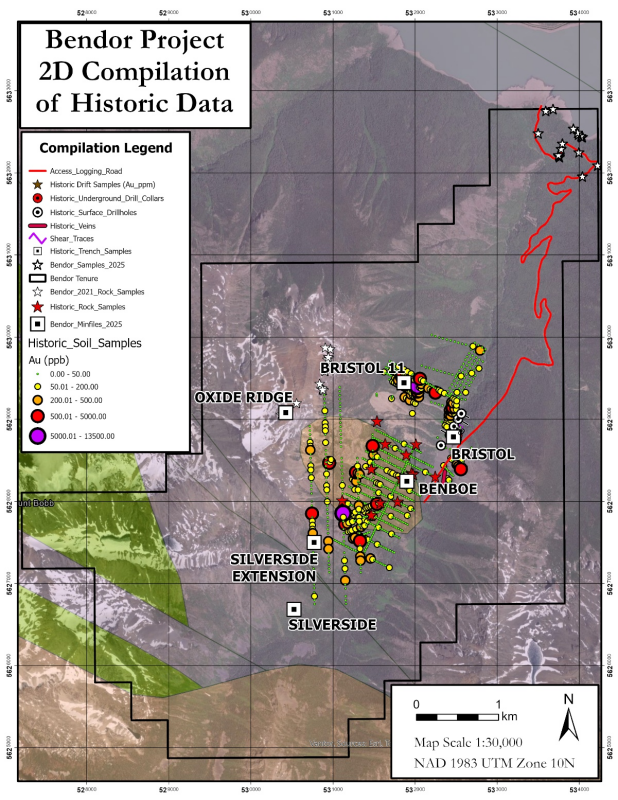
Click Image To View Full Size
Figure 3: Project-wide 2D Data Compilation Results Overview Map
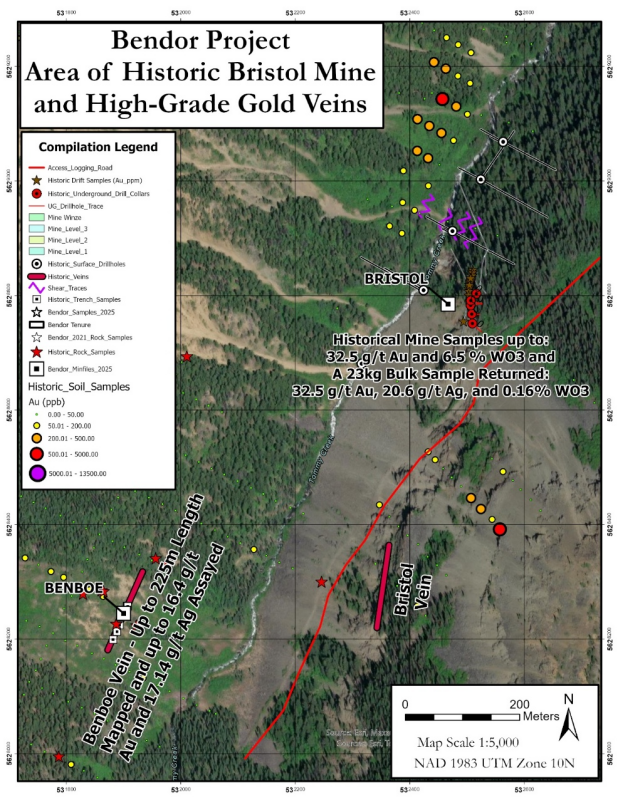
Click Image To View Full Size
Figure 4: Main Shear Zone with Bristol Mine Workings and High-Grade Benboe Vein

Click Image To View Full Size
Figure 5: Bristol Mine Shear Zone and Level 2 Portal – Looking SE

Click Image To View Full Size
Figure 6: Bristol Prospect Underground Workings with Drill Hole Locations and Sample Results
LiDAR and Airborne Magnetic Surveys
Cascade Copper commissioned an airborne LiDAR survey in order to create an accurate elevation model and to analyze the structural complexity of the Project area. The LiDAR survey produced exceptional detail that will allow the Company to interpret the controls on mineralization at Bendor. The LiDAR has shown possible geologic boundaries, major normal fault and thrust fault systems that cross the project as well as structures around the Bendor Pluton that have associated anomalous gold-in-soil values.
The Company has also completed an airborne magnetics-radiometrics survey that shows a strong correlation with geology and mineralization with high magnetic intensity in the south and central portion of the Project where the various Bendor intrusives likely created a hornfelsing of the local lithologies. There also exists a strong correlation of lower or disrupted magnetic intensity to structural complexity and offsets where hydrothermal fluids tend to focus. The highly magnetic central portion of the project is interpreted to be a zone of hornfelsing and hydrothermal alteration with potential magnetite, gold, tungsten, silver, and copper enrichment. The majority of the historic gold-in-soils and surface sampling with high gold values have been associated with this highly underexplored magnetic halo zone.
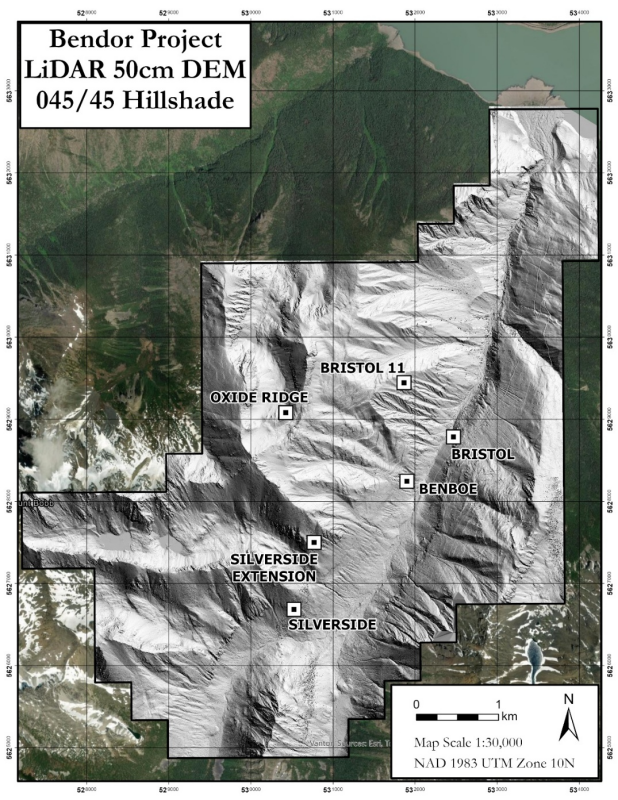
Click Image To View Full Size
Figure 7: LiDAR Image Showing well defined Structural Detail
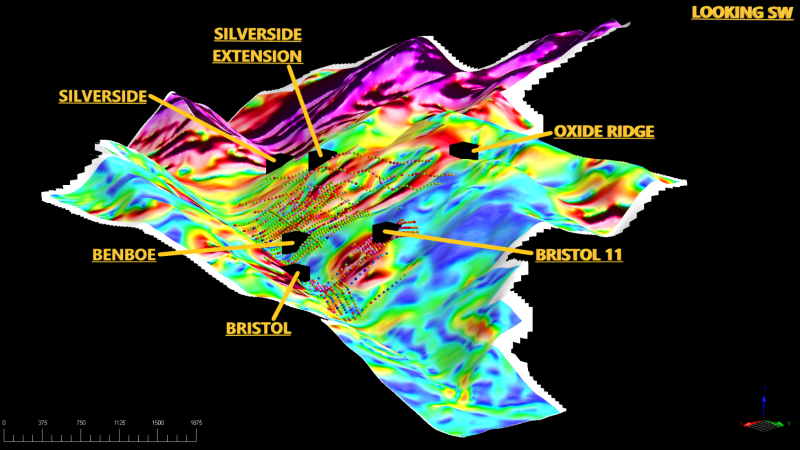
Click Image To View Full Size
Figure 8: Bendor CHG Magnetics Draped on Topography with Historic Soils and Prospects
Magnetic Inversions
Surficial 2D gridding and a coarse preliminary 3D magnetic inversion has been completed on the historic airborne magnetic data flown over the entirety of the Project to test validity of full scale detailed modelling. The Company has now commenced an exercise to perform a 3D inversion on the survey data. Since magnetics appears to correlate well with known geology and mineralization, this will significantly assist in subsurface structural and geological modelling along with potential zones of alteration and mineralization to target in future drilling campaigns.
Near-Term Targets
Compilation and review of all historic surficial and drilling data in combination with the recent airborne magnetics and LiDAR survey data have revealed several targets worthy of “near-term” follow-up in the field. Completion of the 3D magnetic inversion and subsurface modelling is expected to generate additional high-priority targets in preparation for drill permitting and diamond drilling.

Click Image To View Full Size
Figure 9: Airborne Magnetic Survey Indicating Areas of High Magnetic Intensity Associated with Potential Unknown Intrusive Contacts Similar to the Central Bendor Pluton and Gold Mineralization
Next Steps
The recently completed coarse magnetic inversion modelling exercise indicates a strong correlation of anomalous to high grade gold, silver, tungsten, and copper to high magnetics with mineralizing intrusive contacts and low magnetic disruptions associated with structural features focusing hydrothermal fluids that carry the gold. Taking this into account, the Company believes that performing a Project-wide high-resolution refined 3D magnetic inversion will significantly help delineate drill targets. The Company also plans to submit a diamond drilling and geophysics permit application within the next month following completion of the Project-wide 3D magnetic inversion and compilation of historic data. Additionally, surface magnetic and gold-in-soil anomalies will be ground-truthed early in the next field season.
The technical information in this news release was prepared and reviewed by Shannon Baird, P.Geo., a Qualified Person as defined in National Instrument 43-101. Mr. Baird is Vice President of Exploration of Cascade Copper Corp. and registered as a Professional Geoscientist with the Professional Geoscientists of Ontario as well as the Engineers and Geoscientists of British Columbia.
Management cautions that grab samples are selective in nature, and the assay results may not necessarily represent true underlying mineralization.
References for Historical Data
*Please note that all assay values contained within this release are from previous operators, considered to be “historical” in nature, and have not been independently verified by Cascade Copper. The values have been extracted from publicly available government resources including Assessment Reports and MinFile inventory details and it is unknown what type of quality-control programs were performed at the time.
About Cascade Copper
Cascade Copper is an exploration stage natural resource company engaged in the evaluation, acquisition, and exploration of copper based mineral resource properties. Cascade is focused on copper and gold, porphyry and mesothermal gold deposits in British Columbia and VMS and BIF copper, gold and silver style deposits in Ontario. Cascade’s priority is to conduct exploration using modern technology that includes 3D inversion modelling of geophysics, LiDAR derived elevation models and AI enhanced predictive modelling from all historic and modern data inputs. Drilling is planned on several of its copper projects this year. Cascade has five projects, including the Copper Plateau Copper-Moly Project, the Centrefire Copper Project, the Rogers Creek Copper-Gold Project, Fire Mountain Copper-Gold Project and the Bendor Gold Project where it is earning a 100% ownership over 4 years through staged exploration expenditures totalling $275,000 and issuing shares and stock to the vendor.
FOR FURTHER INFORMATION, PLEASE CONTACT:
CASCADE COPPER CORP.
Jeffrey S. Ackert, President and CEO
820-1130 West Pender St.
Vancouver, BC V6E 4A4
Telephone: 1 613 851 7699
E-Mail: info@cascadecopper.com
Web: www.cascadecopper.com
Neither the CSE nor its Regulation Services Provider (as that term is defined in the policies of the CSE) accepts responsibility for the adequacy or accuracy of this release.
DISCLAIMER & FORWARD-LOOKING STATEMENTS
This news release includes certain “forward-looking statements” which are not comprised of historical facts. Forward-looking statements are based on assumptions and address future events and conditions, and by their very nature involve inherent risks and uncertainties. Although these statements are based on currently available information, Cascade Copper Corp. provides no assurance that actual results will meet management’s expectations. Factors which cause results to differ materially are set out in the Company’s documents filed on SEDAR. Undue reliance should not be placed on “forward looking statements.”
Copyright (c) 2025 TheNewswire - All rights reserved.
© 2025 Canjex Publishing Ltd. All rights reserved.